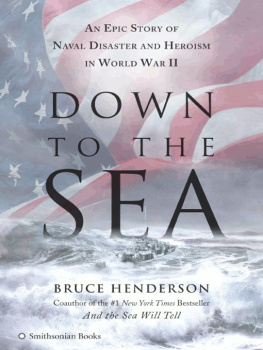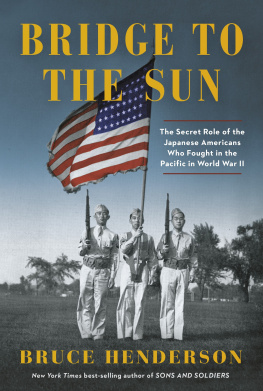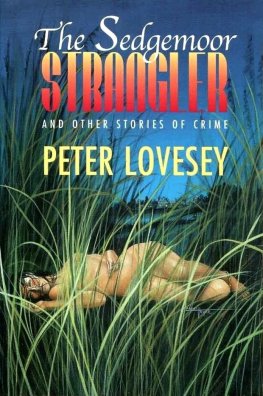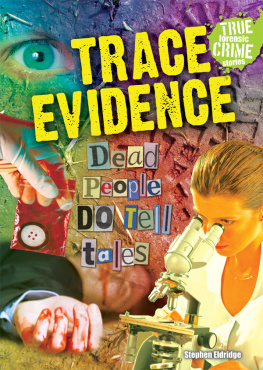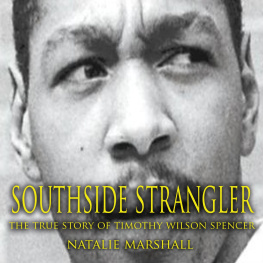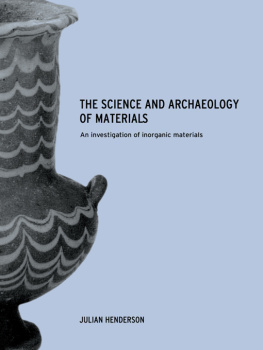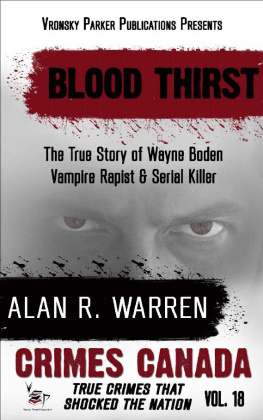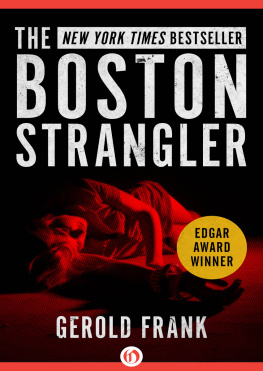Bruce Henderson - Trace Evidence
Here you can read online Bruce Henderson - Trace Evidence full text of the book (entire story) in english for free. Download pdf and epub, get meaning, cover and reviews about this ebook. year: 2013, publisher: Bruce Henderson Books, genre: Detective and thriller. Description of the work, (preface) as well as reviews are available. Best literature library LitArk.com created for fans of good reading and offers a wide selection of genres:
Romance novel
Science fiction
Adventure
Detective
Science
History
Home and family
Prose
Art
Politics
Computer
Non-fiction
Religion
Business
Children
Humor
Choose a favorite category and find really read worthwhile books. Enjoy immersion in the world of imagination, feel the emotions of the characters or learn something new for yourself, make an fascinating discovery.

- Book:Trace Evidence
- Author:
- Publisher:Bruce Henderson Books
- Genre:
- Year:2013
- Rating:5 / 5
- Favourites:Add to favourites
- Your mark:
- 100
- 1
- 2
- 3
- 4
- 5
Trace Evidence: summary, description and annotation
We offer to read an annotation, description, summary or preface (depends on what the author of the book "Trace Evidence" wrote himself). If you haven't found the necessary information about the book — write in the comments, we will try to find it.
Trace Evidence — read online for free the complete book (whole text) full work
Below is the text of the book, divided by pages. System saving the place of the last page read, allows you to conveniently read the book "Trace Evidence" online for free, without having to search again every time where you left off. Put a bookmark, and you can go to the page where you finished reading at any time.
Font size:
Interval:
Bookmark:
And the Sea Will Tell
Fatal North: Murder and Survival on the First North Pole Expedition
Hero Found: The Greatest POW Escape of the Vietnam War
True North: Peary, Cook and the Race to the Pole
EVIDENCE
BRUCE HENDERSON
Trace Evidence: The Hunt for the I-5 Serial Killer
Copyright 1998, 2013 by Bruce Henderson
eISBN: 978-0-9894675-0-6
Published by: BruceHendersonBooks, Menlo Park, CA
www.BruceHendersonBooks.com
All rights reserved. No part of this book shall be reproduced or transmitted in any form or by any means, electronic or mechanical, including photocopying, recording, or by any information storage and retrieval system without prior written permission of the publisher, except where permitted by law. For information, address Writers House LLC at 21 West 26th Street, New York, NY 10010.
For legal reasons, some of the names in this book have been changed.
To those highly trained men and women of law enforcement who are entrusted with the profound responsibility of investigating violent death.
And to the loved ones of murder victims everywherethey who, without ever forgetting, somehow find the strength and courage to go on.
M AY JUSTICE BE SERVED .
CHULA VISTA , CALIFORNIA
It was summertime at the beach.
Palm trees swayed lazily in a steady sea breeze that kept the days balmy and the evenings cool in this San Diego suburb six miles north of the U.S.Mexico border at Tijuana.
After hanging some clothes out to dry, Esther Underwood, thirty-six, of 447 Casselman Street went in the house to iron. Around 4:30 P.M. , she looked out the window and saw that some clothes had apparently blown off the line.
She went outside. Reaching the clothesline, she stood dumbfoundedthere were no clothes on the ground, yet garments were definitely missing. The clothespins that had held them in place were still properly spaced on the line.
She looked around the yard but found nothing. Mentally inventorying the clothes still on the line, she realized that her orchid dress was gone, along with two bathing suits. Also, four pairs of nylon stockings.
She hurried into the house and called the police.
A FTER TAKING A report from the lady at 447 Casselman, patrolmen Don Morrison and Doug Gardner were driving past a nearby park on C Street when they were flagged down by a young girl.
Judy Faureck, age nine, reported that while playing in the park about an hour earlier she had noticed a teenage boy on a green bike enter the park. He had caught her attention because he was riding with a cardboard box on his handlebars and a shovel under one arm. The boy had ridden to a gully next to the public rest rooms, where he parked his bike. Carrying the box and shovel, he crossed to the opposite bank and walked a short distance along the fence line. He then dug a hole adjacent to the fence, put the box inside, and covered it with dirt and leaves. The boy, whom the young witness described as being around fourteen or fifteen years old, about 5-foot-4, with short brown hair and wearing a white T-shirt and Levis, then rode off on his bike.
The officers uncovered the box. Inside, they found the orchid dress and two bathing suits.
The patrolmen contacted a workman they saw cleaning up around the American Legion Hall next to the park. Given the suspects description, custodian Jack Kearns remembered seeing him that day. Kearns didnt know the boys name, but he had previously seen the kid in the park with a boy whose family he did know.
The officers went to the address provided by the custodian. They described the suspect and his bike to the man who answered the door. The man said it sounded like his sons friend who lived on Casselman.
A T THE C HULA V ISTA Police Department the next day, juvenile officer Leo J. Kelly read the report filed by the two patrolmen.
The boy who lived on Casselman had admitted to burying the box in the park. While the fifteen year old denied to the patrol officers that he had stolen the clothes, the officers arrested him for petty theft and prowling. They transported him to the station house, where they made out a contact report. As was customary with juvenile cases, the boy was returned home and turned over to his parents, who were informed that the case would be referred to the departments Juvenile Office for further investigation. The officers had then returned the items of clothing to their owner.
The incident had been the latest in a series of thefts of womens apparel from clotheslines in the same neighborhood. Any type of crime was such an unusual occurrence in this law-abiding town of seventy thousand residents with a police force that numbered only twenty-three officers that the series of clothesline capers had made the news columns of the Chula Vista Star.
Kelly, a U.S. Navy Seabee during the war, was an imposing 6-foot-3 Irishman and father of six childrenfive of them boys. In his five years on the force there had been just one narcotics bust in town. Homicides and armed robberies were virtually unheard of. As far as juveniles went, it was usually pretty minor stuff. Truancy, some runaways, a few burglaries. One sixteen-year-old boy had been caught stealing pocket change from the school office and was sent to Juvenile Hall. When the boy got out, Kelly tried to get him into the Big Brother program but it didnt happen. When the boy went to see if he still had his drugstore job, he found another kid working in his place. Three days later, the boy hanged himself. Kelly hadnt been able to shake the tragedy. The juvenile officer with five sons of his own would never forget the boy who had needed help and understanding but found few adults with the time or inclination to give it to him.
From his four years experience working Juvenile, he knew it would be advisable to confront the errant youngster about the stolen clothes as soon as possible.
When Kelly pulled up in front of the residence at 545 Casselman Street, he saw it was one of those small, cookie-cutter stucco houses with slab floors built after the war that sold mostly to returning GIs for something under $10,000 with nothing down. They all had postage-stamp-size lawns, front and back. More than not, each block had at least one flagpole flying Old Glory.
Kelly knocked on the door, and met the father, a recently retired Navy chief working for the post office. He was told the boys mother was at work. He asked to speak to the fifteen year oldthe oldest of three brothersalone in his bedroom.
The boy sat at the foot of his bed, head hung low. He was a good-looking all-American type, with a thin face and skin freckled from a summer under the sun.
Kelly pulled up the only chair in the room. The juvenile officer had a deep, bass voice that filled a room, even when he spoke softly, as he did now.
I need to know whats been going on, son.
When no answer was forthcoming, Kelly spoke some more in his fatherly yet firm manner, hoping to draw out this sullen boy who shyly made eye contact but remained mute.
When the boy finally did start to talk, Kelly was not surprised that he stuttered. It fit.
The boy confessed to stealing the clothes.
In fact, he admitted much more. He had been taking womens clothes off clotheslines in his neighborhood for the past year. He couldnt say how many times in all but he estimated he had done it about once or twice a week. He usually ended up burying the clothes in the park or throwing them in trash cans.
Did you take only womens clothes? Kelly asked.
Font size:
Interval:
Bookmark:
Similar books «Trace Evidence»
Look at similar books to Trace Evidence. We have selected literature similar in name and meaning in the hope of providing readers with more options to find new, interesting, not yet read works.
Discussion, reviews of the book Trace Evidence and just readers' own opinions. Leave your comments, write what you think about the work, its meaning or the main characters. Specify what exactly you liked and what you didn't like, and why you think so.

